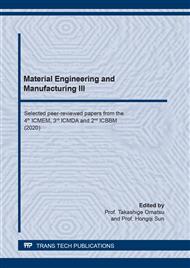[1]
F. Hesse, H. J. Tenzer, Grundlagen der Papierverarbeitung, VEB Verlag fur Buch und Bibliothekswesen, Leipzig, 1963, pp.58-60.
Google Scholar
[2]
S. Mizuguchi (eds), Advanced Technology on Inductrial Packaging and Transportation, Fuji Techno System, Tokyo, 2002, pp.58-59.
Google Scholar
[3]
A. Masud, C. L. Tham, Computational Mechanics in Structural Engineering, Recent Developments, 1999, pp.295-307.
Google Scholar
[4]
S. Nagasawa, H. Sato, D. Yamaguchi, Y. Fukuzawa, I. Katayama, and A. Yoshizawa, Effect of tip clearance and blade hardness on cutting resistance and tip shape in paper board die cutting, Journal of the Japan Society for Technology of Plasticity. 42(2001), 38-42.
Google Scholar
[5]
S. Nagasawa, H. Sekikawa, D. Murayama, Y. Fukuzawa, I. Katayama, Effect of initial tip profile on crushing of center beveled cutter-numerical analysis of crushing tip indented on paperboard, Journal of the Japan Society for Technology of Plasticity. 45(2004) 747-751.
DOI: 10.1016/j.jmatprotec.2004.03.033
Google Scholar
[6]
S. Nagasawa, Y. Fukuzawa, T. Yamaguchi, M. Murayama, D. Yamaguchi & I. Katayama, Effect of blade tip shape on thread dross occurrence in paperboard die cutting, Journal of the Japan Society for Technology of Plasticity. 43(2002), 624-628 (in Japanese).
Google Scholar
[7]
S. Chaijit, S. Nagasawa, Y. Fukuzawa, D. Murayama, I. Katayama, Effect of tip profile on cutting processability of a trapezoidal cutting blade indented to an aluminum sheet, J Mech Mater Struct. 1(2006) 1301-1321.
DOI: 10.2140/jomms.2006.1.1301
Google Scholar
[8]
T. Sugihara, A. Udupa and K. Viswanathan, A plastic boundary layer in wedge indentation of aluminum, Mater Trans. 60(2019) 1436-1441.
DOI: 10.2320/matertrans.md201907
Google Scholar
[9]
M. Murayama, S. Nagasawa, Y. Fukuzawa and I. Katayama, Effect of sheet thickness and friction on load characteristic of crushed center bevel cutter indented to aluminum sheet, Computational Methods in Contact Mechanics VI. 38(2003) 115-124.
DOI: 10.1299/jsmelem.2003.657
Google Scholar
[10]
M. Murayama, S. Nagasawa, Y. Fukuzawa and I. Katayama, Cutting Mechanism and Load Characteristic of Trapezoidal Center Bevel Cutting Indented on Aluminum Sheet,, Japan Soc. of Mech. Eng. Int. 47(2004) 21-28.
DOI: 10.1299/jsmec.47.21
Google Scholar
[11]
Information on https://www.gruber-folien.de/?q=en/products/pape-film, accessed 28th December, (2019).
Google Scholar
[12]
S. Chaijit, S. Nagasawa, Y. Fukuzawa, D. Murayama, A. Hine, Effect of underlay rigidity on cutting characteristic of aluminum foil during wedge shearing process, J. Adv. Mech. Des. Syst. Manuf. 2(2008), 800-811.
DOI: 10.1299/jamdsm.2.800
Google Scholar


